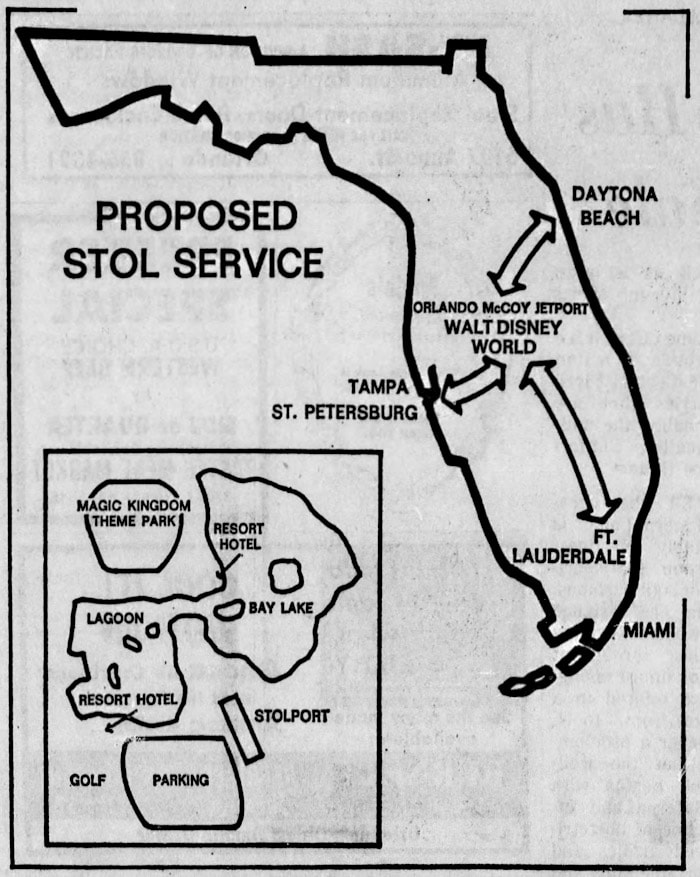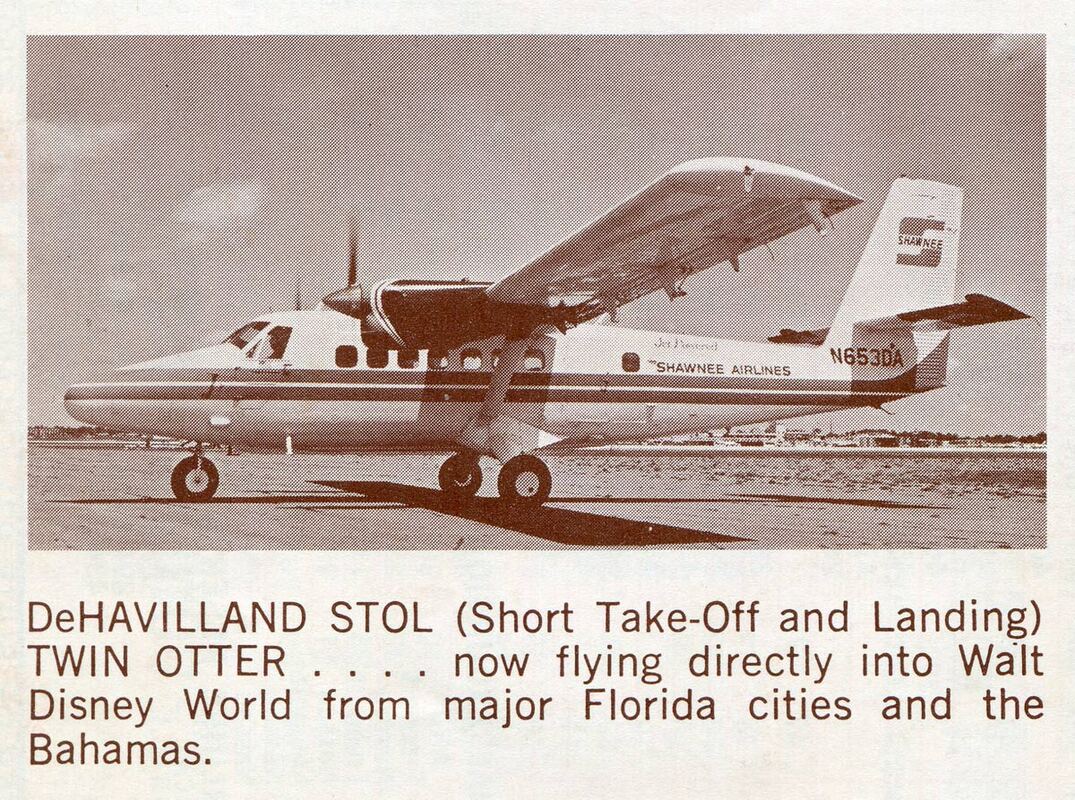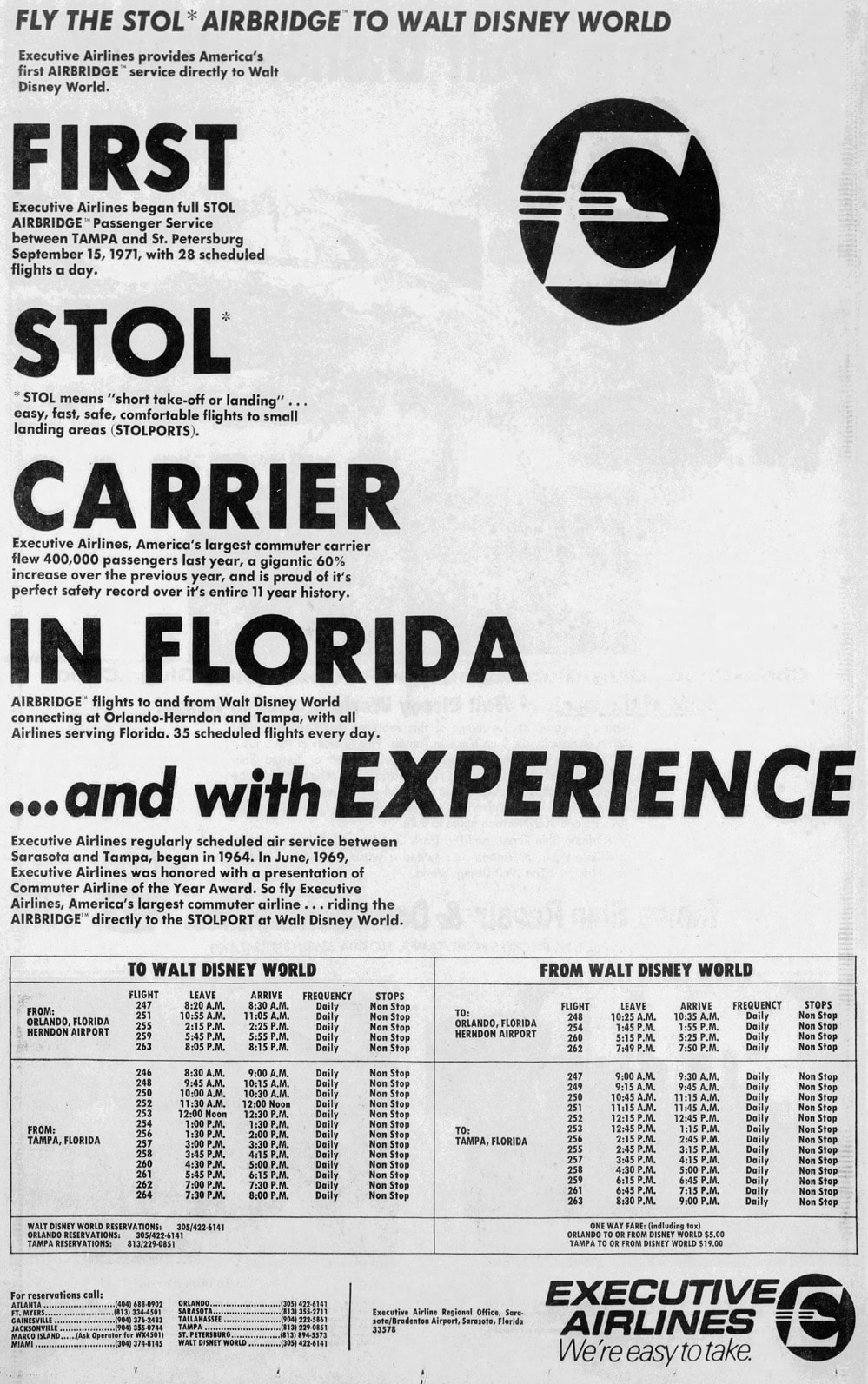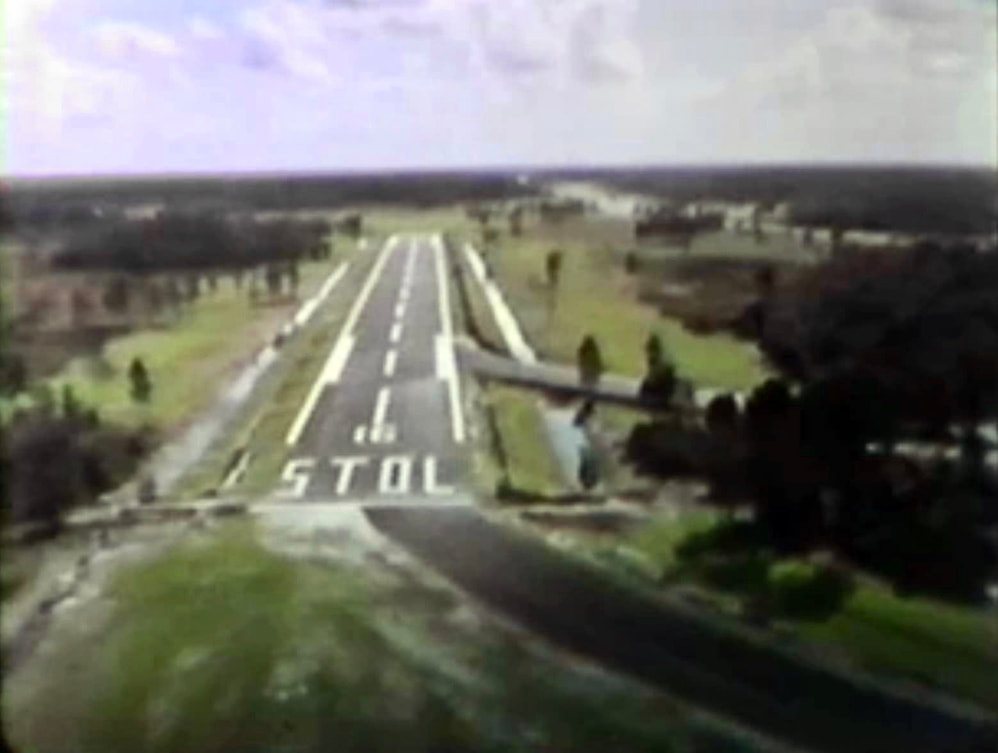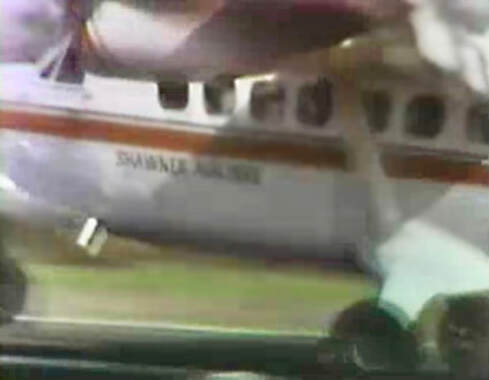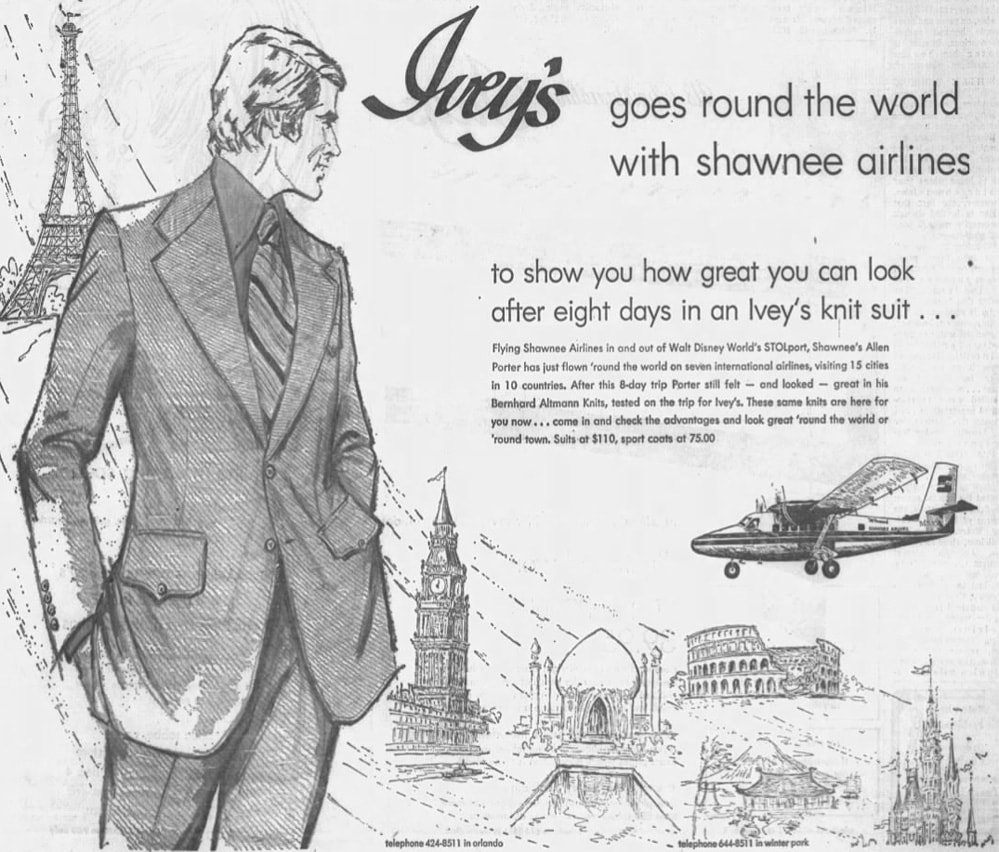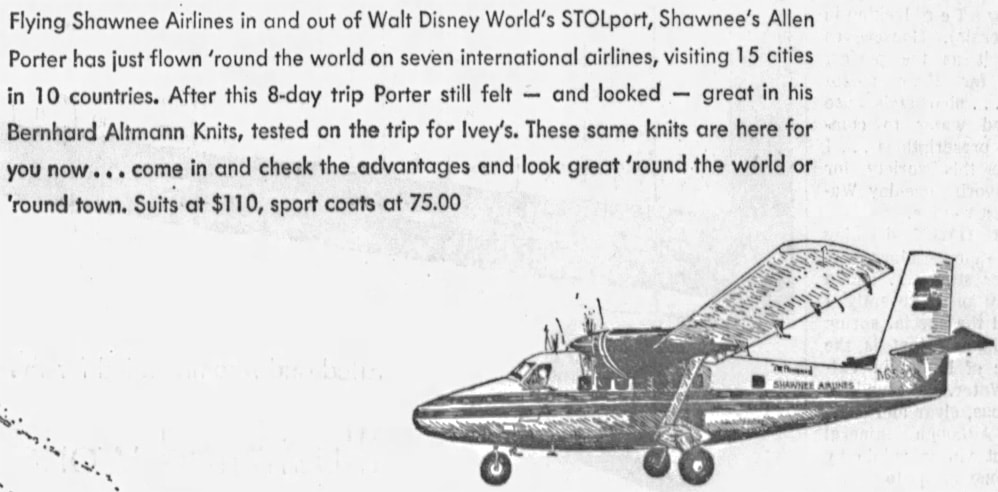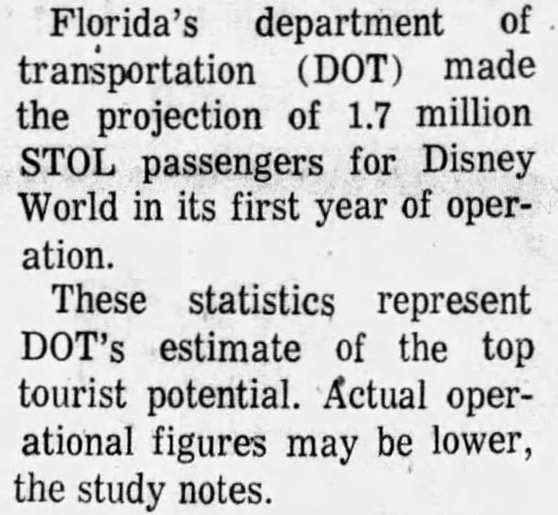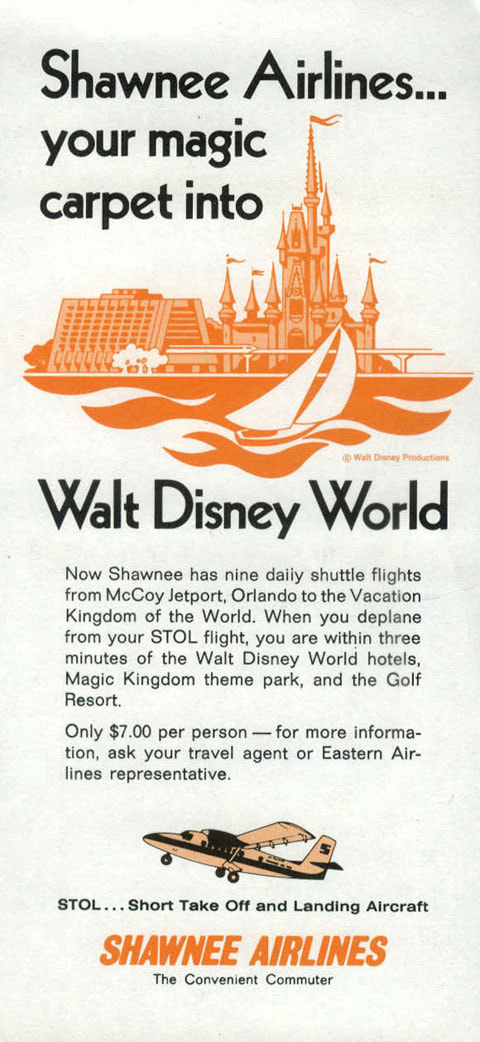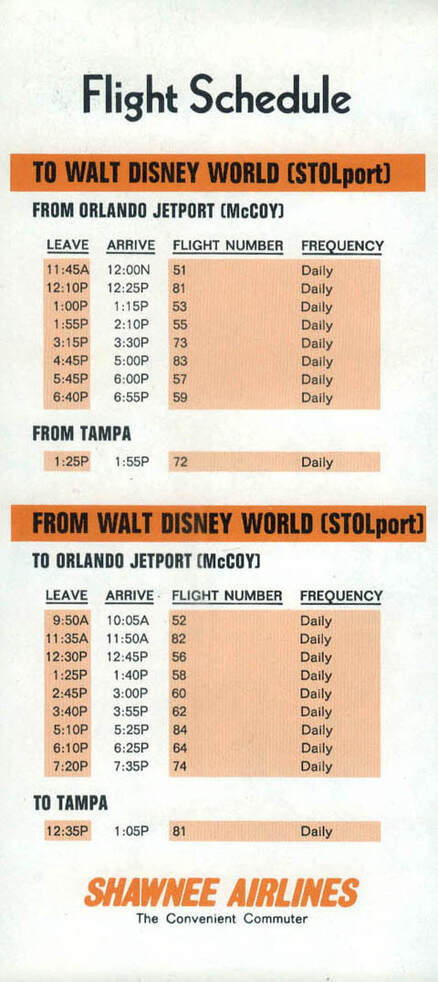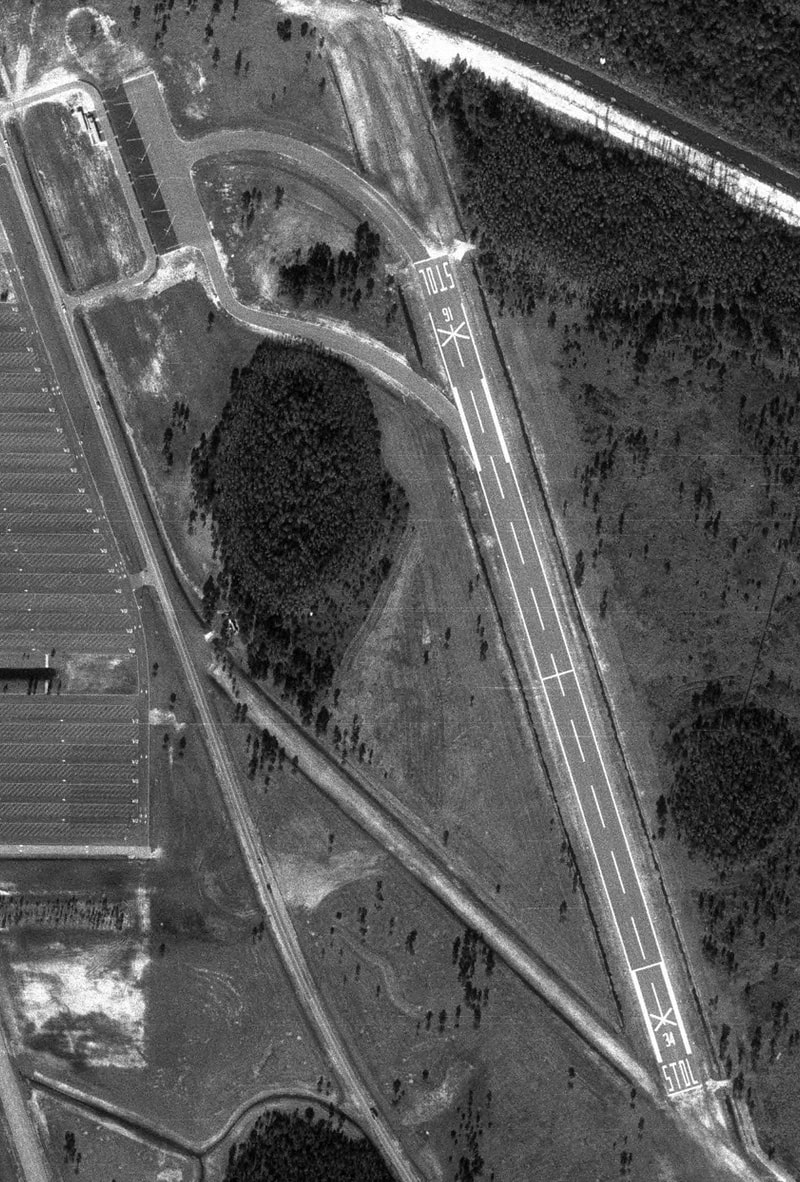HISTORY OF THE WALT DISNEY WORLD STOLPORT
When Walt Disney World opened in October 1971, one of the unique features was a STOL (Short Take Off and Landing) airstrip that would allow commercial passenger flights directly onto the Disney property. Also known as the Lake Buena Vista STOLport, it was little more than a 2,000 foot long runway with a small apron that could accommodate four small commuter planes.
In the early 1970s, the Florida DOT studied the idea of creating a network of STOL airports across the state that would connect resorts and downtown areas using aircraft designed to take off and land in a fraction of the distance required by conventional aircraft. By connecting population centers and tourist attractions directly, the STOL system would theoretically ease congestion on highways and at major airports while allowing passengers to spend less time in transit and more time at their destination. Walt Disney World, scheduled to open in October 1971 and expected to become the top tourist attraction in the state, was the ideal location to test the concept.
By February 1971, the Florida DOT and Disney officials were discussing the possibility of building a STOLport on the Walt Disney World property, seeking to connect the theme park to cities across Florida. The state offered to construct the airstrip and subsidize service for a trial period. Four airlines hoped to secure the potentially lucrative STOL contract: Eastern Airlines, Southern Airways, Shawnee Airlines and Executive Airlines. Before Disney would commit to the idea, several demonstration flights were conducted in April to test the feasibility of the proposals.
Executive and Eastern combined for demonstration flights on April 4, 1971 using an entrance road at Disney World as a runway (it was likely World Drive) using a 19-passenger deHavilland Twin Otter. Eastern hoped to use Executive's service to feed Disney traffic into their mainline flights at Orlando and Tampa and was so convinced of the success of the proposal that they agreed to handle Executive's reservations and offer airport space and management.
Shawnee's demonstration flights took place at Orlando's Herndon Airport three days later on April 7, 1971, also using a Twin Otter. Disney officials were impressed by the ability of the Twin Otters to use a mere 700 feet of runway on both take offs and landings.
By February 1971, the Florida DOT and Disney officials were discussing the possibility of building a STOLport on the Walt Disney World property, seeking to connect the theme park to cities across Florida. The state offered to construct the airstrip and subsidize service for a trial period. Four airlines hoped to secure the potentially lucrative STOL contract: Eastern Airlines, Southern Airways, Shawnee Airlines and Executive Airlines. Before Disney would commit to the idea, several demonstration flights were conducted in April to test the feasibility of the proposals.
Executive and Eastern combined for demonstration flights on April 4, 1971 using an entrance road at Disney World as a runway (it was likely World Drive) using a 19-passenger deHavilland Twin Otter. Eastern hoped to use Executive's service to feed Disney traffic into their mainline flights at Orlando and Tampa and was so convinced of the success of the proposal that they agreed to handle Executive's reservations and offer airport space and management.
Shawnee's demonstration flights took place at Orlando's Herndon Airport three days later on April 7, 1971, also using a Twin Otter. Disney officials were impressed by the ability of the Twin Otters to use a mere 700 feet of runway on both take offs and landings.
On June 28, 1971 Disney publicly announced their plan to build their own STOLport with a 2,000 foot runway and terminal in time for the October opening. They also announced an agreement with Shawnee Airlines to provide connecting flights with major airlines at Orlando McCoy Jetport, Tampa International Airport and other points across the state. Negotiations with Executive Airlines for similar services were soon finalized.
Shawnee and Executive Airlines suffered a major setback in July 1971 when the Air Force, which controlled Orlando McCoy Jetport, announced they would not allow the use of STOL aircraft at the airport, citing the incompatibility of the slow Twin Otters with fighter jets, B-52 bombers and big commercial jets. Until an agreement could be reached, it was decided to serve Orlando through Herndon Airport which was not served by any of the major airlines. The lack of connecting service was a disastrous blow to both Executive and Shawnee.
Both airlines faced another setback when the STOLport was not yet ready for operation when Disney World opened on October 1, 1971. They would have to wait another three weeks for flights to begin. Here's a view of the freshly paved and painted runway. The Magic Kingdom can be seen in the background.
The Disney STOLport was dedicated and opened on Friday October 22, 1971. By the flip of a coin it was decided that Executive Airlines would make the first landing, followed immediately by Shawnee.
Dueling Twin Otters: Mickey Mouse greets the first flights on the morning of October 22 with Executive Airlines in front and Shawnee close behind.
Executive Airlines tested STOL flights between Tampa and St. Petersburg beginning in September 1971 in preparation for their Disney flights. This ad shows 17 daily departures and 18 daily arrivals at Disney World.
Shawnee's entry into the STOL market was more conservative, with 7 daily arrivals and departures shown at Disney World in this November 7, 1971 timetable.
The next three images are courtesy of Blaine Peters. The first view is looking south down runway 16. The aircraft parking area would be out of the frame off to the right. The second view shows a Shawnee Twin Otter over the threshold for runway 34 and the third view shows the Twin Otter passing by. These are apparently screen grabs from an old video. If I can find a copy, I'll post it here.
To prove the point that Shawnee Airlines could offer connecting service between Disney World and any point on Earth, vice president of marketing Allen Porter (along with a Shawnee stewardess) flew around the world and returned 8 days later to the Disney STOLport. According to this November 1971 advertisement, his suit still looked great!
The excitement surrounding the opening of Walt Disney World combined with the hype of STOL flights as the "network of the future" led the Florida DOT to issue a spectacularly optimistic projection of 1.7 million passengers for the first year of operation. To put this in perspective, that would equal roughly 4600 passengers a day. Divide that by the 19-passenger capacity of a Twin Otter and that equals a minimum of 242 daily flights! Shawnee and Executive quickly learned that those estimates bordered on delusional. The majority of seats on Disney STOLport flights were empty.
The Disney flights proved to be a financial disaster for Executive Airlines which blamed the failure of the service for aggravating their already precarious financial situation. Less than seven weeks after inaugurating flights to the Walt Disney World STOLport, Executive shut down its entire Florida system at 7pm on December 9, 1971.
Shawnee Airlines soldiered on at the STOLport through the winter of 1971-1972. In May 1972 they tested an unusual route: a shuttle service between Disney and Maguire Airport , a grass airstrip 9 miles to the north. The idea was that passengers could bypass the frustrating traffic jams that had become common on the highways and roads surrounding the park. The inaugural flight took place May 8, 1972 and was attended by various local mayors, city officials and Disney management. Daily service began on May 15th. The round trip fare for the 8-minute flights was $9.50, equal to about $70 today.
Shawnee was finally granted permission to fly into Orlando Jetport and flights were switched from Herndon Airport to McCoy on August 1, 1972. This allowed connections with the major airlines and Shawnee officials hoped that it might finally generate enough traffic to make a profit on the STOL flights.
While Shawnee never saw a profit on the Disney flights, their success on other routes led major airlines to invade their markets. Unable to compete with large jets, Shawnee ceased operations on December 28, 1972, bringing an end to airline service at the Walt Disney World STOLport only 14 months after the first flight. Airline president David Latham told the press that he intended to keep a skeleton crew to honor a previous commitment for flights to Disney during a convention of the International Newspaper Advertising Executives Association between January 16 and 24, 1973. Those flights marked the end of service at the STOLport. When this aerial photo was taken two weeks later on February 5, the airport was already closed with "X"s painted at both ends of the runway. The proposed terminal was never built and it appears that a trailer (at top left) may have been used instead.
The STOL service that initially carried so much promise was quickly regarded as a failed experiment by Disney and as a total fiasco by the commuter airlines. It's telling that Disney officials commented that the loss of airline service at the airport would have "no significant effect on park attendance". When Shawnee Airlines was resurrected under new ownership later in 1973, the Twin Otters had been disposed of and service was never reinstated to Disney World.
It seemed that Disney might revive the STOLport when deHavilland Canada, the company that manufactured the DHC-6 Twin Otter, conducted flight tests at the airstrip with a new 50-seat Dash 7 STOL aircraft in April 1977. It was proposed that Dash 7 type could be used on commuter flights between Disney World and Atlanta but for whatever reasons, the idea never came to fruition.
More than a half century since its construction, the airstrip is still intact and in recent years has been used to store equipment and Disney vehicles. It remains an odd and unique footnote in Florida's commercial aviation history.
It seemed that Disney might revive the STOLport when deHavilland Canada, the company that manufactured the DHC-6 Twin Otter, conducted flight tests at the airstrip with a new 50-seat Dash 7 STOL aircraft in April 1977. It was proposed that Dash 7 type could be used on commuter flights between Disney World and Atlanta but for whatever reasons, the idea never came to fruition.
More than a half century since its construction, the airstrip is still intact and in recent years has been used to store equipment and Disney vehicles. It remains an odd and unique footnote in Florida's commercial aviation history.



